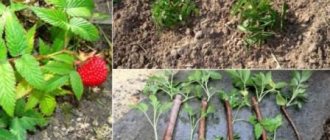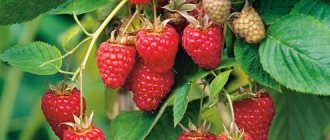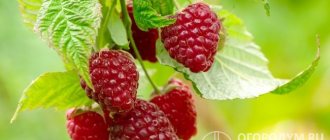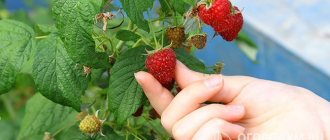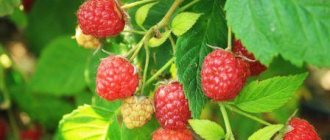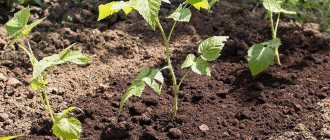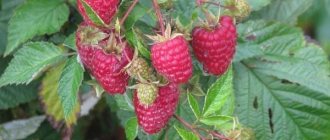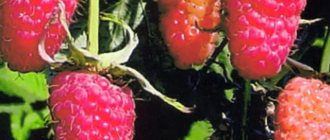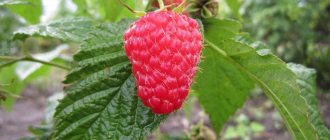There are 4 groups of raspberries: remontant, standard, ordinary and large-fruited. Each of them has a considerable number of varieties and hybrids with different characteristics and requirements for cultivation. One of the most prominent representatives of the latter group is the Stolichnaya raspberry.
Let's look at the detailed description of the variety and choose the best option for growing it. But first, we note that the purchase of Stolichnaya raspberry seedlings must be taken responsibly. You should carefully examine the bush and purchase planting material only from trusted manufacturers, even if their price is higher than on the market.
Characteristics of the Stolichnaya raspberry variety
Large elongated fruit.
High sugar content.
Heap arrangement of berries.
Sweet taste.
Upright compact bush.
Dark green leaves.
The first thing worth mentioning when talking about the Stolichnaya variety is the size of the berries. Large fruits weighing up to 8 grams have an elongated shape and a bright red color.
- Tasting properties are distinguished by a rich sweet taste with slight sourness.
- The sugar content of the berries is higher than that of conventional subshrub varieties.
- The pulp is dense and has a pleasant aroma.
Bush shape
- The elongated cone-shaped shape makes it easy to harvest without damaging the fruit.
- Transportability is satisfactory.
- The high degree of productivity allows the variety to be used for breeding for sale in small farms.
Berry composition
The raspberries of the Stolichnaya variety contain a large number of useful chemicals.
Stolichnaya raspberries are distinguished by their rich chemical composition. They present:
- vitamins of groups B, C, PP and E;
- carotene;
- calcium and sodium;
- phosphorus;
- iron;
- cobalt.
Vitamins E and B are women’s favorite vitamins, responsible for the elasticity and youth of the skin, healing of wounds and scratches. Ascorbic acid (vitamin C) supports the stable functioning of the immune system.
The fruits of the bush are distinguished by a high content of malic and citric acids, as well as pectic nitrogenous and tannin substances . Phytosterol contained in berries lowers cholesterol levels and reduces the risk of cancer. Not only the fruits, but also the leaves of raspberries are rich in microelements. The pectin substances contained in the latter contribute to the rapid removal of toxins from the body and normalization of intestinal microflora.
The sweet taste of Stolichnaya raspberries is due to the high content of copper, which has a beneficial effect on the nervous system. The fruits of this shrub can be consumed in natural and dry form, as well as in compotes, preserves, jams, sauces, desserts and fruit teas.
Features of the variety
The elongated shape of the bush of this raspberry variety is convenient for harvesting.
- The bush itself is upright, medium-high (up to 2 meters), compressed.
- The shoots are powerfully developed, the fruit branches are thickened and, as a rule, have up to 4 orders of branching, which bear 20–25 berries.
- There are no thorns.
- The leaves are dark green with a warty texture and a “ragged” edge.
- Annuals are characterized by a waxy coating, high strength and dark brown color. The subshrub produces no more than 10–12 replacement shoots and no more than 4–5 root shoots.
Reproduction
The growing season for Capital raspberries begins immediately after the snow melts. Therefore, already in March you can think about its reproduction. This variety is characterized by a small number of shoots and root shoots. The optimal method of propagation is to divide the bush into parts.
For propagation, the bush is dug up, trying not to damage the root system. The division must be done so that there are at least 2-3 shoots on each part. In this case, it is better to shorten the stems to 20 cm, so that the plant directs the main forces to rooting. Next season these raspberries will begin to bear fruit.
I live in the Moscow region. The first time I heard from a neighbor that she had planted the Stolichnaya variety, I decided that it was some kind of specially zoned variety for Moscow and the Moscow region. I don’t know whether this is true or not, but for me this variety bears fruit better than all the others. The berries are very large and sweet, some raspberries are as big as Victoria. At the same time, the harvest does not wrinkle even when taking into account the collection in five-liter buckets, where the overlying layers simply consider it their duty to suppress the raspberries that lie in the lower half.
At one time I began to actively study the beneficial qualities of the plants that grow on my site, and I would like to share some conclusions with you. Raspberries are a very useful shrub that can be considered a storehouse of vitamins and beneficial macro- and microelements. The berries contain vitamins B, C, E, PP, calcium, sodium, cobalt, iron. This composition is inherent in any variety, but what Stolichnaya is famous for is its high content of iron and phytosterol, which is considered a means of preventing various forms of oncology and fights cholesterol. I think that in our time of various products from test tubes, it is very important to keep at least something natural and healthy in the diet, so I will try to cultivate my garden as long as I have enough strength and eat natural products and spoil my grandchildren with delicious berries.
The Stolichnaya variety has been respected by gardeners for many years. The latter love this raspberry for its excellent taste, berry size and high yield. Caring for the crop has its own nuances, but, in general, does not differ from growing other varieties.
Advantages and disadvantages
Large fruits are a distinctive feature and advantage of the Stolichnaya raspberry.
The Stolichnaya variety was bred in 1981 at the Institute of Horticulture by Professor V.V. Kichina. It was put on sale in 1984 and immediately became extremely popular among gardeners due to its many advantages, such as:
- high productivity;
- large fruit;
- excellent tasting qualities;
- medium-high winter hardiness (up to -25–30°C);
- absence of thorns;
- ease of care;
- resistance to diseases such as anthracnose and spider mites.
In addition, the berries do not fall off immediately after ripening, as happens with most conventional varieties.
Flaws
Among the disadvantages are:
- small amount of shoots produced;
- susceptibility to purple spot and verticillium wilt.
The demand for the variety and its poor propagation leads to high prices for seedlings.
Landing rules
Preparation of planting holes.
Place the root collar at soil level.
Abundant watering after planting.
Mulching with humus.
Securing seedlings on a trellis.
- Raspberry bushes are very light-loving . This rule applies to absolutely all varieties. The root surface system of the subshrub places special demands on the soil. It should be well loosened, fertile and moist. The soil acidity level should not exceed 5.5–6.5 pH.
- A high degree of acidity requires additional addition of lime to the soil . For 1 m² of loam there is 0.3 kg of sand or 0.5 kg of lime flour. The middle level changes the proportions by 0.2 and 0.3, respectively.
- You can also reduce acidity using wood ash . The latter contains up to 35% calcium, as well as additional microelements (phosphorus, potassium), which promote intensive plant growth.
- Ground chalk is suitable for any type of soil . Dolomite flour is useful for soils lacking magnesium. As a rule, this is sandy and sandy loam soil.
- Seedlings are planted in holes or small trenches 0.3–0.4 m deep and 30 cm wide . There is no need to bury the plant. But adding organic fertilizer is not only possible, but also necessary. Humus, humus or simple manure are suitable for this. After compacting the soil, new seedlings should be watered generously. In the future, watering is carried out regularly at the rate of 30–40 liters per m².
- Despite the upright growth and strong, durable branches of the bush, it is advisable to use a trellis . This procedure is performed not so much to give stability to the stems, but to allow uniform illumination of the entire subshrub.
Care
During the season, raspberries are fed three times, adding fertilizer to the moist soil.
The Stolichnaya raspberry variety is quite easy to care for. In the first few years, it does not require fertilizing, since the fertilizer added during the planting process is sufficient. The main thing is to water on time and abundantly.
After 2–3 years, during the fruiting period, nitrogen, phosphorus and potassium fertilizers can be applied in the form of wood ash, superphosphate or potassium sulfate.
Good winter hardiness allows the Stolichny variety to easily tolerate frosts in the middle zone. In northern latitudes, it is recommended to bend the shoots to the ground no higher than 30 cm and sprinkle them with hay, straw or spruce branches.
Trimming
Raspberry pruning is done taking into account the two-year life cycle.
Raspberry pruning should be done in late fall or early spring. This procedure is a good prevention of various diseases and creates a beautiful aesthetic appearance of the raspberry tree.
Sanitary pruning of shoots is carried out annually.
In the process, damaged, diseased and weak branches are removed, as well as dead two-year-old shoots. Thinning is often carried out during the process. A large number of shoots growing inside the raspberry tree leads to a lack of light and nutrients.
Care
Watering plants
Freshly planted and established raspberries need constant watering, especially during periods of lack of rain. The main thing here is not to overdo it; excess moisture can lead to soaking of the roots.
You can water the bush (10 liters) with water that has stood for 12 hours to prevent stress on the roots. Gardeners also use sprinkling in the morning and evening hours. The best option is drip irrigation.
Fertilizer for raspberries Stolichnaya
With proper pre-planting soil preparation, raspberries do not need additional fertilizer for 2-3 years. The Stolichnaya variety successfully bears fruit without additional care.
To increase the quantity and quality of the harvest in the spring, you can add a bucket of rotted manure under the bush. After flowering, you can add mineral fertilizers. In summer, the rows are filled with ash at the rate of 0.5 liters per square meter.
Before fertilizing, the mulching straw must be removed and the peat must be dug up, then the nutrients will get into the roots faster.
Trimming
Raspberry Stolichnaya has a two-year development cycle, so pruning and shaping the bush takes place in two stages:
- In June, the top of the young shoot is pinched 10-15 cm, and side shoots grow.
- In the spring of next year, the side branches are shortened by 10-15 cm, and a well-fruiting bush is formed.
In early spring and autumn, cuttings are carried out at the root of diseased and old shoots. During the season, dried, frozen, fruit-bearing shoots are cut back to living tissue.
More on the topic: Raspberry variety Pride of Russia (Giant)
Reviews and recommendations from gardeners
The Stolichnaya variety has been known in our country for more than 20 years. And all these years his popularity has not waned. Amateur gardeners are attracted by the ease of care, the durability of the bush and large tasty berries with a sweet and sour taste and a delicate aroma. Farmers engaged in industrial cultivation on a small scale like the high yield of the variety and the low financial costs of maintaining it. The main disadvantage, according to both sides, is the high price of planting material and the low possibilities of independent reproduction.
Users and owners of raspberry gardens also note the variety’s good frost resistance, resistance to pests and diseases. Raspberries of this type do not have thorns, therefore they are safe for children and convenient for harvesting. It is easy to tie up and does not require annual feeding.
Stolichnaya raspberries are rightfully called one of the best among all types of large-fruited varieties. The numerous advantages clearly outweigh the minor disadvantages. You should purchase seedlings of this variety from trusted sellers or large stores that have all the necessary certification.

